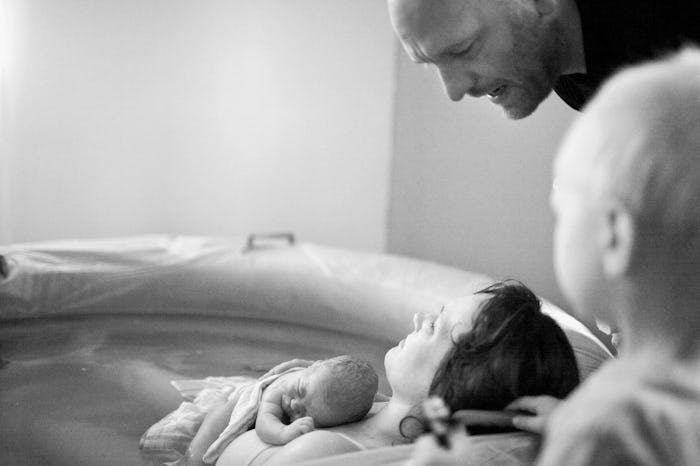Life
How To Have A Home Birth, Because Your Bathtub Is Your Favorite Spot To Be
Planning for the birth of your baby is one of the most important things you’ll ever think about. Birth, especially in the United States, has come a long way from the days of twilight sleep, but many women are turning to one of the oldest practices in the world — the home birth. According to the Centers for Disease Control, 1.36 percent of births in 2012 occurred outside of a hospital and 66 percent of those were home births. With so many moms-to-be making the move from hospital to home, more and more people are wondering if and how to have a home birth.
As to whether they should or should, there are plenty of reasons to pregnant women to consider a home birth. So many women are looking for a chance to birth naturally, in a comfortable surrounding, and without the fear of unnecessary medical interventions. Not only are you allowed to fill the room with those you love, including other children, but the American Pregnancy Association notes that you’re also able to move around and change positions, avoiding the one-size-fits-all birthing plan of most hospitals. A recent study also found that an uncomplicated vaginal birth costs, on average, 68 percent less in a home than a hospital. But having a home birth is more than just grabbing some towels and boiling water. It takes a lot of planning and work, but if it’s something you’re truly committed to having, it can be one of the greatest experiences of your life. I spoke with childbirth educator and birth doula Samantha Van Vleet of Intuitive Childbirth to find out what you need to focus on when planning a home birth.
1Make Sure Your Pregnancy Is Healthy
It’s best to be considered a low-risk, healthy pregnancy when planning for a home birth. “There are some situations in which a home birth might not be safe,” Van Vleet says. “Midwives are regulated in most states to transfer care to a hospital if the mother is experiencing preeclampsia, preterm labor, or other conditions that could make the delivery outside of a midwife’s scope of practice.” If you’re worried about your pregnancy risks, speak with your midwife and voice your concerns.
2Have A Backup Plan
No matter how specific you plan your birth, anything can happen. This is Mother Nature, after all. “For most women, the backup plan won’t be needed, but the last thing you want is to have some unexpected complication arise and suddenly, you don’t know what to do,” Van Vleet says. Think about the hospital you’ll go to if something goes wrong, how you’ll get there, and what doctor you’ll want to see in your backup plan.
3Click With Your Birthing Partners
Many couples prefer a home birth because of the intimate setting and the freedom to birth their child the way they want. Because of that, you want to make sure you click with your midwife and birthing team. “Make sure your desires for your birth mesh well with your provider’s practices,” says Van Vleet. “The last thing you want is some unwelcome stranger dampening the mood in your own home.” Meet with your birthing partners and midwives often to form a relationship and feel comfortable.
4Hire A Doula
“Doulas are an invaluable source of emotional, physical, and practical support during labor,” Van Vleet says. These home birth partners are nurturers and are there to strictly provide support for you, making your experience exactly what you want. If you aren’t sure when to find a doula, ask your midwife if they have any recommendations.
5Educate Yourself
You may have a great team of licensed professionals, but you still need to know what’s going on with your home birth. “Familiarize yourself with birth,” Van Vleet says. “Really delve into it. Pretend you’re studying for a midwifery exam and then study some more. The more prepared and aware you are, the calmer you’ll be.” Knowledge is power, right? Embrace it.
6Write A Birth Plan
Although she notes that birth plans aren’t for everyone, Van Vleet also says they can be pretty important. “Ideally, everyone should have their desires down on paper prior to labor and delivery,” she says. “Good starting points include what you want to do with your placenta, delivery positions, if you want to eat and drink during labor, labor interventions, and newborn exams.” Planning your home birth exactly like you want doesn’t always mean it will happen that way, but it can help during labor. No one wants to experience contractions and try to explain to someone how they wanted the bathtub filled. Let your birthing partners in on your plan so they know what you’re expecting, too.
7Prepare Your Home
Know you want candles, vacuumed carpet, and Netflix on? Make it happen. The whole point of a home birth is to deliver your child in a comfortable surrounding that gives you the freedom to make it what you want. You can also use this time to get all of the things ready for your home birth. “I had a water birth,” Van Vleet says. “I thought I had everything ready to go only to realize halfway through my labor that I forgot a hose to fill the pool.” She also suggests doing a practice run as you prepare to make sure everything is where it should be.
